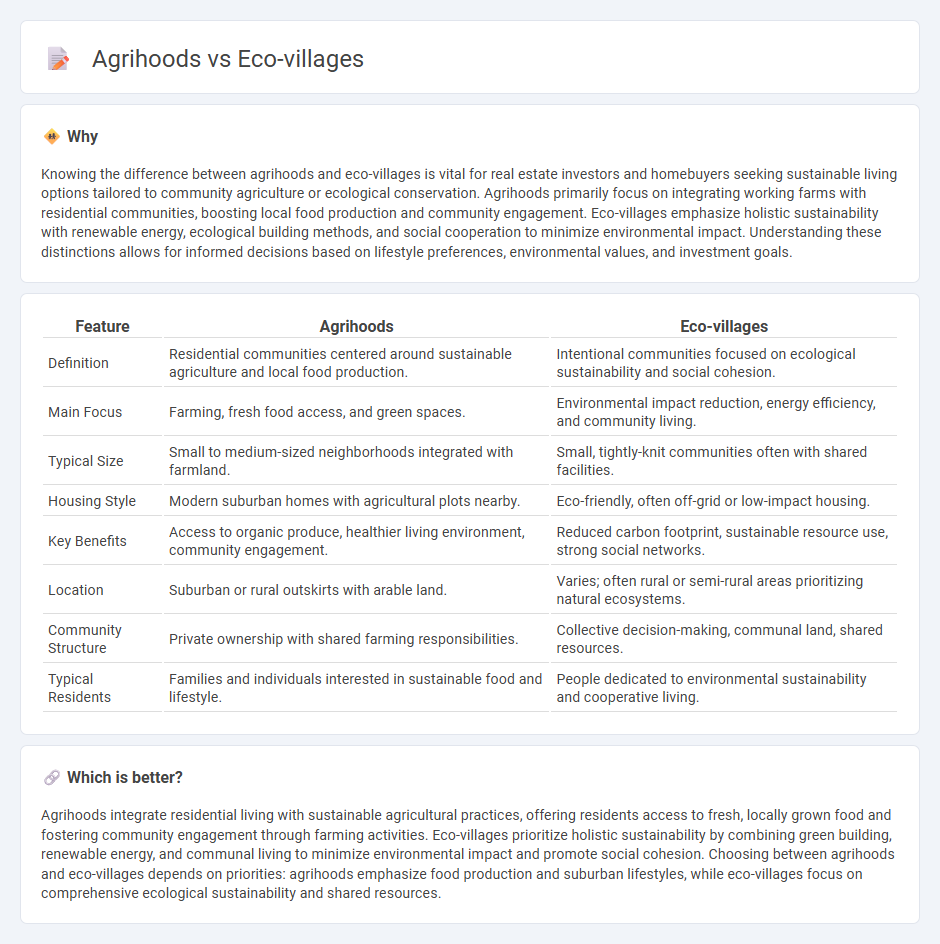
Agrihoods integrate agriculture directly into residential communities, promoting sustainable living through local food production and green spaces. Eco-villages emphasize holistic environmental practices and social cooperation to create self-sustaining, low-impact communities. Discover how these innovative real estate models are reshaping community planning and lifestyle choices.
Why it is important
Knowing the difference between agrihoods and eco-villages is vital for real estate investors and homebuyers seeking sustainable living options tailored to community agriculture or ecological conservation. Agrihoods primarily focus on integrating working farms with residential communities, boosting local food production and community engagement. Eco-villages emphasize holistic sustainability with renewable energy, ecological building methods, and social cooperation to minimize environmental impact. Understanding these distinctions allows for informed decisions based on lifestyle preferences, environmental values, and investment goals.
Comparison Table
| Feature | Agrihoods | Eco-villages |
|---|---|---|
| Definition | Residential communities centered around sustainable agriculture and local food production. | Intentional communities focused on ecological sustainability and social cohesion. |
| Main Focus | Farming, fresh food access, and green spaces. | Environmental impact reduction, energy efficiency, and community living. |
| Typical Size | Small to medium-sized neighborhoods integrated with farmland. | Small, tightly-knit communities often with shared facilities. |
| Housing Style | Modern suburban homes with agricultural plots nearby. | Eco-friendly, often off-grid or low-impact housing. |
| Key Benefits | Access to organic produce, healthier living environment, community engagement. | Reduced carbon footprint, sustainable resource use, strong social networks. |
| Location | Suburban or rural outskirts with arable land. | Varies; often rural or semi-rural areas prioritizing natural ecosystems. |
| Community Structure | Private ownership with shared farming responsibilities. | Collective decision-making, communal land, shared resources. |
| Typical Residents | Families and individuals interested in sustainable food and lifestyle. | People dedicated to environmental sustainability and cooperative living. |
Which is better?
Agrihoods integrate residential living with sustainable agricultural practices, offering residents access to fresh, locally grown food and fostering community engagement through farming activities. Eco-villages prioritize holistic sustainability by combining green building, renewable energy, and communal living to minimize environmental impact and promote social cohesion. Choosing between agrihoods and eco-villages depends on priorities: agrihoods emphasize food production and suburban lifestyles, while eco-villages focus on comprehensive ecological sustainability and shared resources.
Connection
Agrihoods and eco-villages share a common focus on sustainable living by integrating agriculture and community design to promote environmental stewardship and local food production. Both real estate developments prioritize green spaces, renewable energy, and eco-friendly building practices to reduce carbon footprints and enhance residents' quality of life. This synergy supports resilient ecosystems and fosters close-knit communities centered around shared environmental values.
Key Terms
Sustainability
Eco-villages emphasize holistic sustainability by integrating renewable energy, waste reduction, and community-driven environmental practices. Agrihoods prioritize sustainable agriculture within residential neighborhoods, promoting local food production and green spaces that enhance biodiversity. Explore the unique sustainability approaches and benefits of eco-villages and agrihoods to understand their impact on eco-friendly living.
Community Design
Eco-villages prioritize sustainable living through collective resource management, shared spaces, and strong social bonds, fostering a deep sense of community interconnectedness. Agrihoods integrate residential neighborhoods with working farms, emphasizing local food production while encouraging community engagement through shared agricultural activities. Explore the distinct design principles behind eco-villages and agrihoods to discover how they shape sustainable communities.
Local Food Systems
Eco-villages prioritize self-sustaining local food systems by integrating permaculture, organic farming, and community-supported agriculture to enhance food security and ecological balance. Agrihoods center on residential neighborhoods designed around a working farm, offering residents fresh, locally grown produce while fostering community engagement and environmental stewardship. Explore the unique benefits of these models in promoting sustainable local food systems and resilient communities.
Source and External Links
Ecovillages From Around the World for Sustainable Living - Earth.Org - Ecovillages are intentional or traditional communities aiming for social, cultural, ecological, and economic sustainability through local participatory processes, minimizing environmental impact, and promoting positive innovation worldwide.
What is an Eco-Village and How Can it Combat Climate Change? - Eco-villages promote sustainability with self-sufficiency, renewable energy, permaculture farming, resource sharing, and climate-adaptive infrastructure to reduce carbon footprints and regenerate natural spaces.
5 of the World's Coolest EcoVillages - The World Economic Forum - Findhorn EcoVillage in Scotland exemplifies an ecovillage with low ecological footprints, sustainable architecture, community-owned renewable energy, and programs educating about sustainability and climate action.
 dowidth.com
dowidth.com